Computerized Cognitive Training in the Older Workforce: Effects on Cognition, Life Satisfaction, and Productivity
Abstract
:1. Introduction
1.1. Older Workforce
1.2. Cognitive Aging
1.3. Cognitive Training (CT)
1.4. Cognitive Training with Older Workers
1.5. Purpose of the Present Study
2. Methods
2.1. Participants
2.2. Study Design
2.3. Training Procedures
2.4. Computerized Spatial Navigation Training (CCT) Protocol
2.5. Outcome Measures
2.5.1. Neuropsychological Tests
- (a)
- Letter Verbal Fluency (LVF) Test: In this test, participants were instructed to write down as many words as possible that begin with the letter “F” in the first testing session and “S” in the second testing session, within a time limit of 60 s.
- (b)
- Semantic Verbal Fluency (SVF) Test: Participants were asked to verbally generate and write down as many words as possible from the semantic categories of ‘animals’ during the Pre-CCT testing and ‘fruits & vegetables’ during the post-CCT testing. They were allotted 60 s for each category.
2.5.2. Questionnaires
2.6. Productivity
2.7. CCT Satisfaction Measure
2.8. Statistical Procedures
3. Results
3.1. Sample Univariate Description
3.2. CCT Effectiveness
3.3. CCT Effects on Productivity and Well-Being
4. Discussion
4.1. CCT and Cognitive Functioning
4.2. CCT and Work Productivity
4.3. CCT and Well-Being
4.4. Limitations of the Study
5. Conclusions
Author Contributions
Funding
Institutional Review Board Statement
Informed Consent Statement
Data Availability Statement
Acknowledgments
Conflicts of Interest
References
- Schmidt, F.L. The Role of General Cognitive Ability and Job Performance: Why There Cannot Be a Debate. In Role of General Mental Ability in industrial, Work, and Organizational Psychology; Psychology Press: London, UK, 2002; ISBN 978-1-4106-0880-2. [Google Scholar]
- Ree, M.J.; Earles, J.A.; Teachout, M.S. Predicting Job Performance: Not Much More than g. J. Appl. Psychol. 1994, 79, 518–524. [Google Scholar] [CrossRef]
- Aiyar, S.; Ebeke, C. The Impact of Workforce Aging on European Productivity. IMF Work. Pap. 2016, 16, 1. [Google Scholar] [CrossRef]
- Baltes, M.M.; Carstensen, L.L. The Process of Successful Aging: Selection, Optimization, and Compensation. In Understanding Human Development: Dialogues with Lifespan Psychology; Staudinger, U.M., Lindenberger, U., Eds.; Springer: Boston, MA, USA, 2003; pp. 81–104. ISBN 978-1-4615-0357-6. [Google Scholar]
- Kubeck, J.E.; Delp, N.D.; Haslett, T.K.; McDaniel, M.A. Does Job-Related Training Performance Decline with Age? Psychol. Aging 1996, 11, 92–107. [Google Scholar] [CrossRef] [PubMed]
- Schooler, C.; Mulatu, M.S.; Oates, G. The Continuing Effects of Substantively Complex Work on the Intellectual Functioning of Older Workers. Psychol. Aging 1999, 14, 483. [Google Scholar] [CrossRef] [PubMed]
- Bosma, H.; van Boxtel, M.P.; Ponds, R.W.; Houx, P.J.; Burdorf, A.; Jolles, J. Mental Work Demands Protect against Cognitive Impairment: MAAS Prospective Cohort Study. Exp. Aging Res. 2003, 29, 33–45. [Google Scholar] [CrossRef] [PubMed]
- Marquié, J.-C.; Duarte, L.R.; Bessières, P.; Dalm, C.; Gentil, C.; Ruidavets, J.B. Higher Mental Stimulation at Work Is Associated with Improved Cognitive Functioning in Both Young and Older Workers. Ergonomics 2010, 53, 1287–1301. [Google Scholar] [CrossRef] [PubMed]
- Correa Ribeiro, P.C.; de Souza Lopes, C.; Alves Lourenço, R. Prevalence of Dementia in Elderly Clients of a Private Health Care Plan: A Study of the FIBRA-RJ, Brazil. Dement. Geriatr. Cogn. Disord. 2013, 35, 77–86. [Google Scholar] [CrossRef]
- Curreri, C.; Trevisan, C.; Grande, G.; Giantin, V.; Ceolin, C.; Maggi, S.; Noale, M.; Baggio, G.; Sergi, G. The Influence of Occupation Type and Complexity on Cognitive Performance in Older Adults. Psychiatry Res. Neuroimaging 2022, 326, 111542. [Google Scholar] [CrossRef] [PubMed]
- Kleineidam, L.; Wolfsgruber, S.; Weyrauch, A.-S.; Zulka, L.E.; Forstmeier, S.; Roeske, S.; van den Bussche, H.; Kaduszkiewicz, H.; Wiese, B.; Weyerer, S.; et al. Midlife Occupational Cognitive Requirements Protect Cognitive Function in Old Age by Increasing Cognitive Reserve. Front. Psychol. 2022, 13, 957308. [Google Scholar] [CrossRef]
- Craik, F.I.; Bialystok, E. Brain Changes in Development and Aging. Trends Cogn. Sci. 2006, 3, 131–138. [Google Scholar] [CrossRef]
- Kavčič, V. Umovadba; Založba Miš: Domžale, Slovenia, 2015. [Google Scholar]
- Bläsing, B. Dance Expertise, Embodied Cognition, and the Body in the Brain. In Dance Data, Cognition, and Multimodal Communication; Routledge: Oxford, UK, 2022; pp. 223–243. [Google Scholar]
- Salthouse, T.A. The Processing-Speed Theory of Adult Age Differences in Cognition. Psychol. Rev. 1996, 103, 403–428. [Google Scholar] [CrossRef] [PubMed]
- West, R.L. An Application of Prefrontal Cortex Function Theory to Cognitive Aging. Psychol. Bull. 1996, 120, 272–292. [Google Scholar] [CrossRef]
- Marusic, U.; Grosprêtre, S. Non-physical Approaches to Counteract Age-related Functional Deterioration: Applications for Rehabilitation and Neural Mechanisms. Eur. J. Sport Sci. 2018, 18, 639–649. [Google Scholar] [CrossRef]
- Bahar-Fuchs, A.; Martyr, A.; Goh, A.M.; Sabates, J.; Clare, L. Cognitive Training for People with Mild to Moderate Dementia. Cochrane Database Syst. Rev. 2019, 3, CD013069. [Google Scholar] [CrossRef]
- Saczynski, J.S.; Rebok, G.W.; Whitfield, K.E.; Plude, D.L. Spontaneous Production and Use of Mnemonic Strategies in Older Adults. Exp. Aging Res. 2007, 33, 273–294. [Google Scholar] [CrossRef]
- Buiza, C.; Etxeberria, I.; Galdona, N.; González, M.F.; Arriola, E.; De Munain, A.L.; Urdaneta, E.; Yanguas, J.J. A Randomized, Two-year Study of the Efficacy of Cognitive Intervention on Elderly People: The Donostia Longitudinal Study. Int. J. Geriat. Psychiatry 2008, 23, 85–94. [Google Scholar] [CrossRef]
- Corbett, A.; Owen, A.; Hampshire, A.; Grahn, J.; Stenton, R.; Dajani, S.; Burns, A.; Howard, R.; Williams, N.; Williams, G.; et al. The Effect of an Online Cognitive Training Package in Healthy Older Adults: An Online Randomized Controlled Trial. J. Am. Med. Dir. Assoc. 2015, 16, 990–997. [Google Scholar] [CrossRef]
- Klimova, B. Computer-Based Cognitive Training in Aging. Front. Aging Neurosci. 2016, 8. [Google Scholar] [CrossRef]
- Ball, K.; Berch, D.B.; Helmers, K.F.; Jobe, J.B.; Leveck, M.D.; Marsiske, M.; Morris, J.N.; Rebok, G.W.; Smith, D.M.; Tennstedt, S.L.; et al. Effects of Cognitive Training Interventions with Older AdultsA Randomized Controlled Trial. JAMA 2002, 288, 2271–2281. [Google Scholar] [CrossRef]
- Marusic, U.; Verghese, J.; Mahoney, J.R. Cognitive-Based Interventions to Improve Mobility: A Systematic Review and Meta-Analysis. J. Am. Med. Dir. Assoc. 2018, 19, 484–491.e3. [Google Scholar] [CrossRef] [PubMed]
- Marusic, U.; Verghese, J.; Mahoney, J.R. Does Cognitive Training Improve Mobility, Enhance Cognition, and Promote Neural Activation? Front. Aging Neurosci. 2022, 14, 845825. [Google Scholar] [CrossRef] [PubMed]
- Gates, N.J.; Rutjes, A.W.; Di Nisio, M.; Karim, S.; Chong, L.-Y.; March, E.; Martínez, G.; Vernooij, R.W. Computerised Cognitive Training for Maintaining Cognitive Function in Cognitively Healthy People in Midlife. Cochrane Database Syst. Rev. 2019, 3, CD012278. [Google Scholar] [CrossRef] [PubMed]
- Kelly, M.E.; Loughrey, D.; Lawlor, B.A.; Robertson, I.H.; Walsh, C.; Brennan, S. The Impact of Cognitive Training and Mental Stimulation on Cognitive and Everyday Functioning of Healthy Older Adults: A Systematic Review and Meta-Analysis. Ageing Res. Rev. 2014, 15, 28–43. [Google Scholar] [CrossRef] [PubMed]
- Žepič, Z.M. Improvement of Cognitive Abilities of Older Employees with Computerized Cognitive Training (CCT). IFAC-Pap. 2021, 54, 651–656. [Google Scholar] [CrossRef]
- Makin, S. Brain Training: Memory Games. Nature 2016, 531, S10–S11. [Google Scholar] [CrossRef] [PubMed]
- Traut, H.J.; Guild, R.M.; Munakata, Y. Why Does Cognitive Training Yield Inconsistent Benefits? A Meta-Analysis of Individual Differences in Baseline Cognitive Abilities and Training Outcomes. Front. Psychol. 2021, 12, 662139. [Google Scholar] [CrossRef] [PubMed]
- Abd-Alrazaq, A.; Alajlani, M.; Alhuwail, D.; Toro, C.T.; Giannicchi, A.; Ahmed, A.; Makhlouf, A.; Househ, M. The Effectiveness and Safety of Serious Games for Improving Cognitive Abilities among Elderly People with Cognitive Impairment: Systematic Review and Meta-Analysis. JMIR Serious Games 2022, 10, e34592. [Google Scholar] [CrossRef] [PubMed]
- von Bastian, C.C.; Reinhartz, A.; Udale, R.C.; Grégoire, S.; Essounni, M.; Belleville, S.; Strobach, T. Mechanisms of Processing Speed Training and Transfer Effects across the Adult Lifespan: Protocol of a Multi-Site Cognitive Training Study. BMC Psychol 2022, 10, 168. [Google Scholar] [CrossRef]
- Sala, G.; Aksayli, N.D.; Tatlidil, K.S.; Tatsumi, T.; Gondo, Y.; Gobet, F. Near and Far Transfer in Cognitive Training: A Second-Order Meta-Analysis. Collabra Psychol. 2019, 5, 18. [Google Scholar] [CrossRef]
- von Bastian, C.C.; Hyde, E.R.; Jiang, S. Tackling Cognitive Decline in Late Adulthood: Cognitive Interventions. Curr. Opin. Psychol. 2024, 56, 101780. [Google Scholar] [CrossRef]
- Olegário, R.L.; Fernandes, S.R.; de Moraes , R., Jr. Efficacy of Cognitive Training on Executive Functions in Healthy Older Adults: A Systematic Review with Meta-Analysis of Randomized Controlled Trials. Psychol. Health 2023, 1–28. [Google Scholar] [CrossRef] [PubMed]
- Marusic, U.; Žepič, Z.; Kavčič, V. Učinkovitost Računalniškega Kognitivnega Treninga v Domovih Starejših Občanov/Effectiveness of Computerized Cognitive Training in Nursing Homes. Psihol. Obz./Horiz. Psychol. 2021, 30, 47–54. [Google Scholar] [CrossRef]
- Borness, C.; Proudfoot, J.; Crawford, J.; Valenzuela, M. Putting Brain Training to the Test in the Workplace: A Randomized, Blinded, Multisite, Active-Controlled Trial. PLoS ONE 2013, 8, e59982. [Google Scholar] [CrossRef] [PubMed]
- Gajewski, P.D.; Freude, G.; Falkenstein, M. Cognitive Training Sustainably Improves Executive Functioning in Middle-Aged Industry Workers Assessed by Task Switching: A Randomized Controlled ERP Study. Front. Hum. Neurosci. 2017, 11. [Google Scholar] [CrossRef] [PubMed]
- Lampit, A.; Ebster, C.; Valenzuela, M. Multi-Domain Computerized Cognitive Training Program Improves Performance of Bookkeeping Tasks: A Matched-Sampling Active-Controlled Trial. Front. Psychol. 2014, 5. [Google Scholar] [CrossRef] [PubMed]
- Miller, S.; Chelian, S.; Mcburnett, W.; Tsou, W.; Kruse, A. An Investigation of Computer-Based Brain Training on the Cognitive and EEG Performance of Employees. In Proceedings of the 2019 41st Annual International Conference of the IEEE Engineering in Medicine and Biology Society (EMBC), Berlin, Germany, 23–27 July 2019; pp. 518–521. [Google Scholar]
- Lampit, A.; Hallock, H.; Valenzuela, M. Computerized Cognitive Training in Cognitively Healthy Older Adults: A Systematic Review and Meta-Analysis of Effect Modifiers. PLoS Med. 2014, 11, e1001756. [Google Scholar] [CrossRef] [PubMed]
- Arslanian-Engoren, C.; Giordani, B.; Nelson, K.; Moser, D.K. A Pilot Study to Evaluate a Computer-Based Intervention to Improve Self-Care in Patients with Heart Failure. J. Cardiovasc. Nurs 2021, 36, 157–164. [Google Scholar] [CrossRef] [PubMed]
- Ezeamama, A.E.; Sikorskii, A.; Sankar, P.R.; Nakasujja, N.; Ssonko, M.; Kaminski, N.E.; Guwatudde, D.; Boivin, M.J.; Giordani, B. Computerized Cognitive Rehabilitation Training for Ugandan Seniors Living with HIV: A Validation Study. JCM 2020, 9, 2137. [Google Scholar] [CrossRef] [PubMed]
- Marusic, U.; Kavcic, V.; Giordani, B.; Gerževič, M.; Meeusen, R.; Pišot, R. Computerized Spatial Navigation Training during 14 Days of Bed Rest in Healthy Older Adult Men: Effect on Gait Performance. Psychol. Aging 2015, 30, 334–340. [Google Scholar] [CrossRef]
- Slatenšek, B.; Kavčič, V.; Bakračevič, K. Učinek Računalniškega Kognitivnega Treninga Prostorske Navigacije Na Kognitivne Sposobnosti Pri Nadarjenih Učencih. Psihol. Obz./Horiz. Psychol. 2021, 30, 101–111. [Google Scholar] [CrossRef]
- Mahne, N.; Bakračevič, K.; Kavčič, V. Računalniški Kognitivni Trening Pri Otrocih in Mladostnikih z Lažjo Motnjo v Duševnem Razvoju. Psihol. Obz./Horiz. Psychol. 2021, 30, 79–87. [Google Scholar] [CrossRef]
- Rey, A. L’examen Psychologique Dans Les Cas d’encéphalopathie Traumatique. (Les Problems). Arch. Psychol. 1941, 28, 215–285. [Google Scholar]
- Schmidt, M. Rey Auditory Verbal Learning Test: RAVLT: A Handbook; Western Psychological Services: Beaverton, OR, USA, 1996. [Google Scholar]
- Lezak, M.D. Neuropsychological Assessment; Oxford University Press: Oxford, UK, 2004; ISBN 978-0-19-511121-7. [Google Scholar]
- Spreen, O.; Strauss, E. A Compendium of Neuropsychological Tests, 2nd ed.; Oxford University Press: New York, NY, USA, 1998. [Google Scholar]
- Fernaeus, S.-E.; Östberg, P.; Wahlund, L.-O.; Hellström, Å. Memory Factors in Rey AVLT: Implications for Early Staging of Cognitive Decline. Scand. J. Psychol. 2014, 55, 546–553. [Google Scholar] [CrossRef] [PubMed]
- Aita, S.L.; Beach, J.D.; Taylor, S.E.; Borgogna, N.C.; Harrell, M.N.; Hill, B.D. Executive, Language, or Both? An Examination of the Construct Validity of Verbal Fluency Measures. Appl. Neuropsychol. Adult 2018, 26, 441–451. [Google Scholar] [CrossRef] [PubMed]
- Barry, D.; Bates, M.E.; Labouvie, E. FAS and CFL Forms of Verbal Fluency Differ in Difficulty: A Meta-Analytic Study. Appl. Neuropsychol. 2008, 15, 97–106. [Google Scholar] [CrossRef] [PubMed]
- Boivin, M.J.; Giordani, B.; Berent, S.; Amato, D.A.; Lehtinen, S.; Koeppe, R.A.; Buchtel, H.A.; Foster, N.L.; Kuhl, D.E. Verbal Fluency and Positron Emission Tomographic Mapping of Regional Cerebral Glucose Metabolism. Cortex 1992, 28, 231–239. [Google Scholar] [CrossRef] [PubMed]
- Weschler, D. Weschler Adult Intelligence Scale, 3rd ed.; Psychological Corporation: New York, NY, USA, 1997. [Google Scholar]
- Matarazzo, J.D.; Herman, D.O. Base Rate Data for the WAIS-R: Test-Retest Stability and VIQ-PIQ Differences. J. Clin. Exp. Neuropsychol. 1984, 6, 351–366. [Google Scholar] [CrossRef] [PubMed]
- Rosano, C.; Perera, S.; Inzitari, M.; Newman, A.B.; Longstreth, W.T.; Studenski, S. Digit Symbol Substitution Test and Future Clinical and Subclinical Disorders of Cognition, Mobility and Mood in Older Adults. Age Ageing 2016, 45, 688–695. [Google Scholar] [CrossRef] [PubMed]
- Salthouse, T.A.; Babcock, R.L.; Shaw, R.J. Effects of Adult Age on Structural and Operational Capacities in Working Memory. Psychol. Aging 1991, 6, 118–127. [Google Scholar] [CrossRef] [PubMed]
- Salthouse, T.A.; Babcock, R.L. Decomposing Adult Age Differences in Working Memory. Dev. Psychol. 1991, 27, 763–776. [Google Scholar] [CrossRef]
- Spector, P.E. Job Satisfaction: Application, Assessment, Causes, and Consequences; SAGE: Thousand Oaks, CA, USA, 1997; Volume 3, ISBN 0-7619-8923-4. [Google Scholar]
- Fields, D.L. Taking the Measure of Work: A Guide to Validated Scales for Organizational Research and Diagnosis; SAGE: Thousand Oaks, CA, USA, 2002; ISBN 0-7619-2425-6. [Google Scholar]
- Van Saane, N.; Sluiter, J.K.; Verbeek, J.; Frings-Dresen, M.H. Reliability and Validity of Instruments Measuring Job Satisfaction—A Systematic Review. Occup. Med. 2003, 53, 191–200. [Google Scholar] [CrossRef]
- Podlesek, A.; Komidar, L.; Kavcic, V. The Relationship Between Perceived Stress and Subjective Cognitive Decline During the COVID-19 Epidemic. Front. Psychol. 2021, 12, 647971. [Google Scholar] [CrossRef] [PubMed]
- Diener, E.D.; Emmons, R.A.; Larsen, R.J.; Griffin, S. The Satisfaction with Life Scale. J. Personal. Assess. 1985, 49, 71–75. [Google Scholar] [CrossRef] [PubMed]
- Pavot, W.; Diener, E. Review of the Satisfaction with Life Scale. Psychol. Assess. 1993, 5, 164. [Google Scholar] [CrossRef]
- World Health Organization. Use of Well-Being Measures in Primary Health Care-the DepCare Project Health for All. Target 1998, 12, E60246. [Google Scholar]
- Topp, C.W.; Østergaard, S.D.; Søndergaard, S.; Bech, P. The WHO-5 Well-Being Index: A Systematic Review of the Literature. Psychother. Psychosom. 2015, 84, 167–176. [Google Scholar] [CrossRef] [PubMed]
- Cohen, J. Statistical Power Analysis for the Behavioral Sciences; Routledge: New York, NY, USA, 1988. [Google Scholar]
- Lithfous, S.; Dufour, A.; Després, O. Spatial Navigation in Normal Aging and the Prodromal Stage of Alzheimer’s Disease: Insights from Imaging and Behavioral Studies. Ageing Res. Rev. 2013, 12, 201–213. [Google Scholar] [CrossRef] [PubMed]
- Jebara, N.; Orriols, E.; Zaoui, M.; Berthoz, A.; Piolino, P. Effects of Enactment in Episodic Memory: A Pilot Virtual Reality Study with Young and Elderly Adults. Front. Aging Neurosci. 2014, 6, 338. [Google Scholar] [CrossRef] [PubMed]
- Moffat, S.D.; Kennedy, K.M.; Rodrigue, K.M.; Raz, N. Extrahippocampal Contributions to Age Differences in Human Spatial Navigation. Cereb. Cortex 2007, 17, 1274–1282. [Google Scholar] [CrossRef] [PubMed]
- Taillade, M.; Sauzéon, H.; Dejos, M.; Arvind Pala, P.; Larrue, F.; Wallet, G.; Gross, C.; N’Kaoua, B. Executive and Memory Correlates of Age-Related Differences in Wayfinding Performances Using a Virtual Reality Application. Aging Neuropsychol. Cogn. 2013, 20, 298–319. [Google Scholar] [CrossRef]
- Nguyen, L.; Murphy, K.; Andrews, G. Immediate and Long-Term Efficacy of Executive Functions Cognitive Training in Older Adults: A Systematic Review and Meta-Analysis. Psychol. Bull. 2019, 145, 698–733. [Google Scholar] [CrossRef]
- Marusic, U.; Giordani, B.; Moffat, S.D.; Petrič, M.; Dolenc, P.; Pišot, R.; Kavcic, V. Computerized Cognitive Training during Physical Inactivity Improves Executive Functioning in Older Adults. Aging Neuropsychol. Cogn. 2016, 25, 49–69. [Google Scholar] [CrossRef]
- Nedeljko, M.; Gu, Y.; Bostan, C.M. The Dual Impact of Technological Tools on Health and Technostress among Older Workers: An Integrative Literature Review. Cogn. Technol. Work 2024, 26, 47–61. [Google Scholar] [CrossRef]
- Kang, S.Y.; Lee, C.M. Effects of a Cognitive Improvement Program on Cognition, Activities of Daily Living (ADL), Depression, Life Satisfaction, and Grasping Power in Small Groups. J. Muscle Jt. Health 2016, 23, 169–178. [Google Scholar] [CrossRef]
- Gordon, E.; Palmer, D.M.; Liu, H.; Rekshan, W.; DeVarney, S. Online Cognitive Brain Training Associated with Measurable Improvements in Cognition and Emotional Well-Being. Technol. Innov. 2013, 15, 53–62. [Google Scholar] [CrossRef]
- Sheng, C.; Yang, K.; Wang, X.; Li, H.; Li, T.; Lin, L.; Liu, Y.; Yang, Q.; Wang, X.; Wang, X.; et al. Advances in Non-Pharmacological Interventions for Subjective Cognitive Decline: A Systematic Review and Meta-Analysis. J. Alzheimer’s Dis. 2020, 77, 903–920. [Google Scholar] [CrossRef] [PubMed]
- Boyle, E.A.; Hainey, T.; Connolly, T.M.; Gray, G.; Earp, J.; Ott, M.; Lim, T.; Ninaus, M.; Ribeiro, C.; Pereira, J. An Update to the Systematic Literature Review of Empirical Evidence of the Impacts and Outcomes of Computer Games and Serious Games. Comput. Educ. 2016, 94, 178–192. [Google Scholar] [CrossRef]
- Lumsden, J.; Edwards, E.A.; Lawrence, N.S.; Coyle, D.; Munafò, M.R. Gamification of Cognitive Assessment and Cognitive Training: A Systematic Review of Applications and Efficacy. JMIR Serious Games 2016, 4, e11. [Google Scholar] [CrossRef] [PubMed]
- Pallavicini, F.; Ferrari, A.; Mantovani, F. Video Games for Well-Being: A Systematic Review on the Application of Computer Games for Cognitive and Emotional Training in the Adult Population. Front. Psychol. 2018, 9, 2127. [Google Scholar] [CrossRef] [PubMed]
- Sakuraya, A.; Imamura, K.; Watanabe, K.; Asai, Y.; Ando, E.; Eguchi, H.; Nishida, N.; Kobayashi, Y.; Arima, H.; Iwanaga, M.; et al. Corrigendum: What Kind of Intervention Is Effective for Improving Subjective Well-Being among Workers? A Systematic Review and Meta-Analysis of Randomized Controlled Trials. Front. Psychol. 2023, 14, 1236746. [Google Scholar] [CrossRef]
- Jean, L.; Bergeron, M.-È.; Thivierge, S.; Simard, M. Cognitive Intervention Programs for Individuals with Mild Cognitive Impairment: Systematic Review of the Literature. Am. J. Geriatr. Psychiatry 2010, 18, 281–296. [Google Scholar] [CrossRef]
- Gajewski, P.D.; Stahn, C.; Zülch, J.; Wascher, E.; Getzmann, S.; Falkenstein, M. Effects of Cognitive and Stress Management Training in Middle-Aged and Older Industrial Workers in Different Socioeconomic Settings: A Randomized Controlled Study. Front. Psychol. 2023, 14, 1229503. [Google Scholar] [CrossRef] [PubMed]
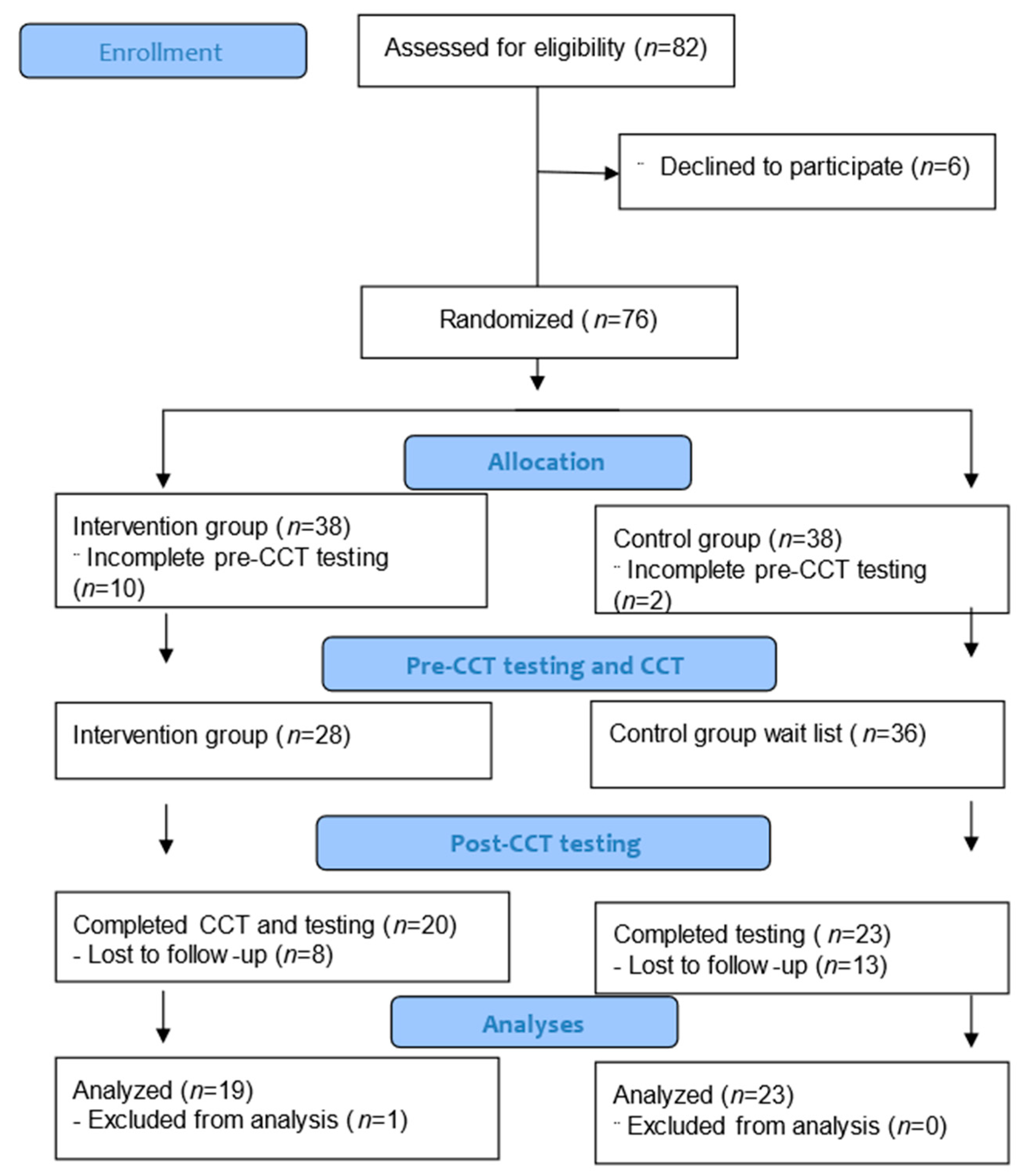
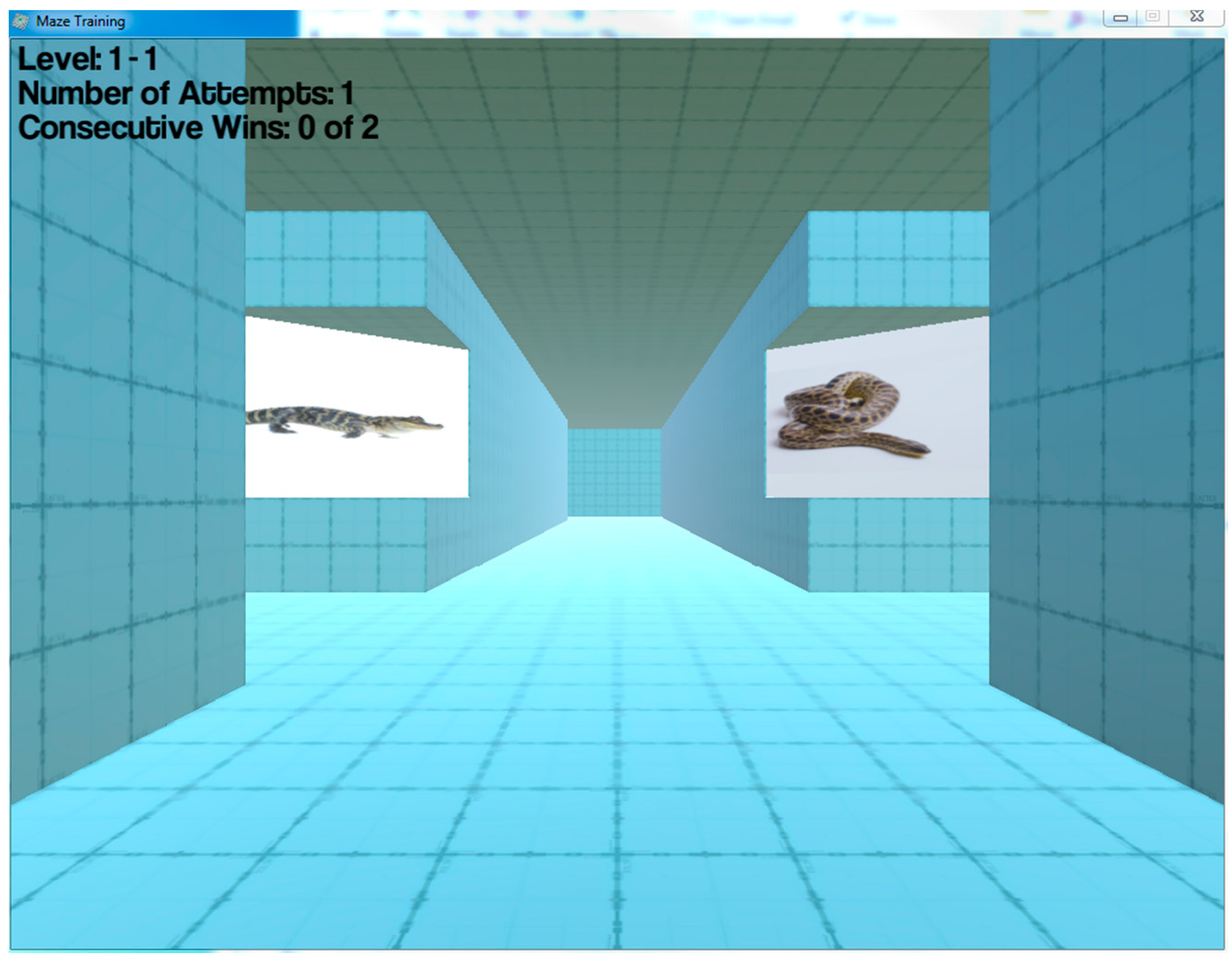
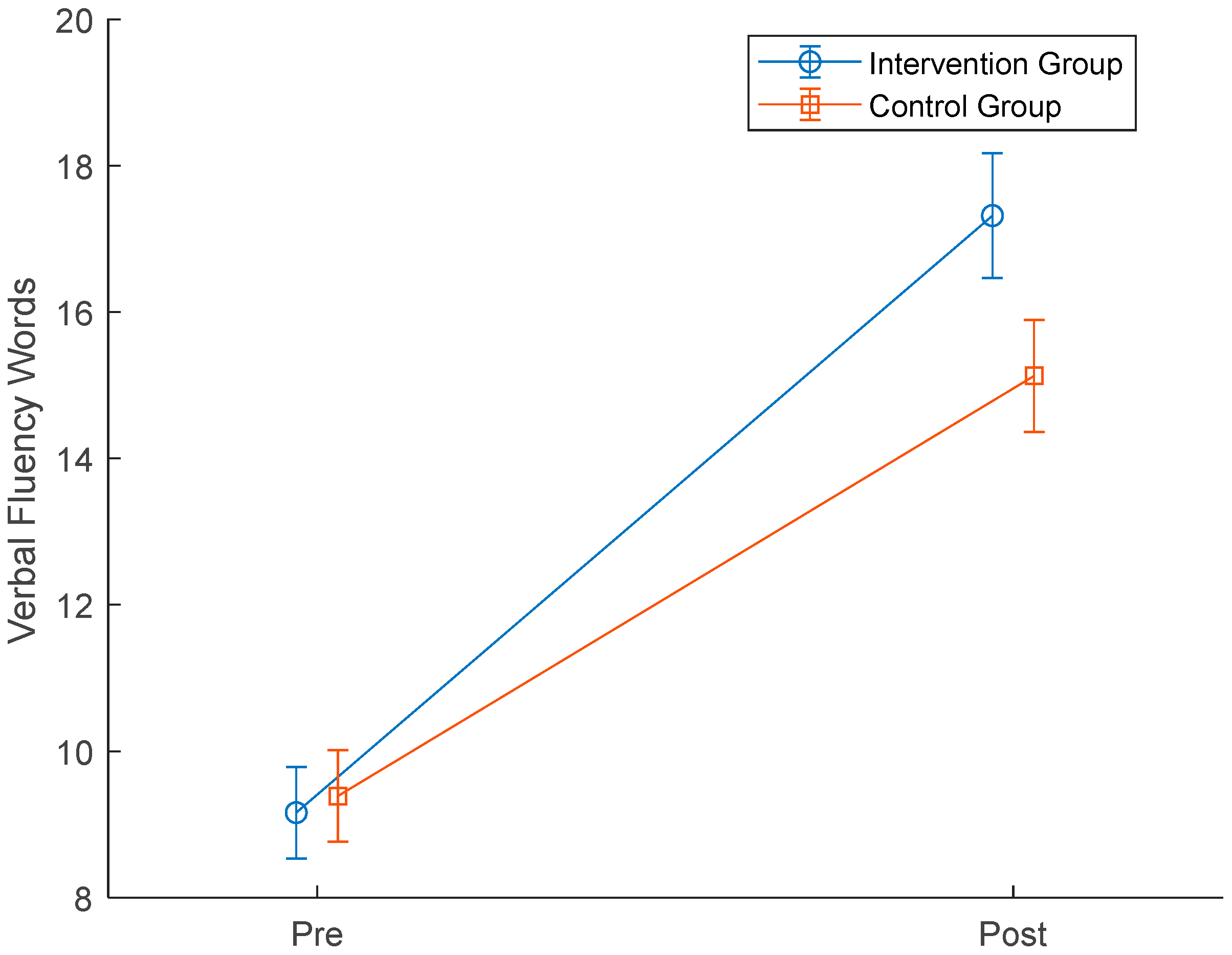
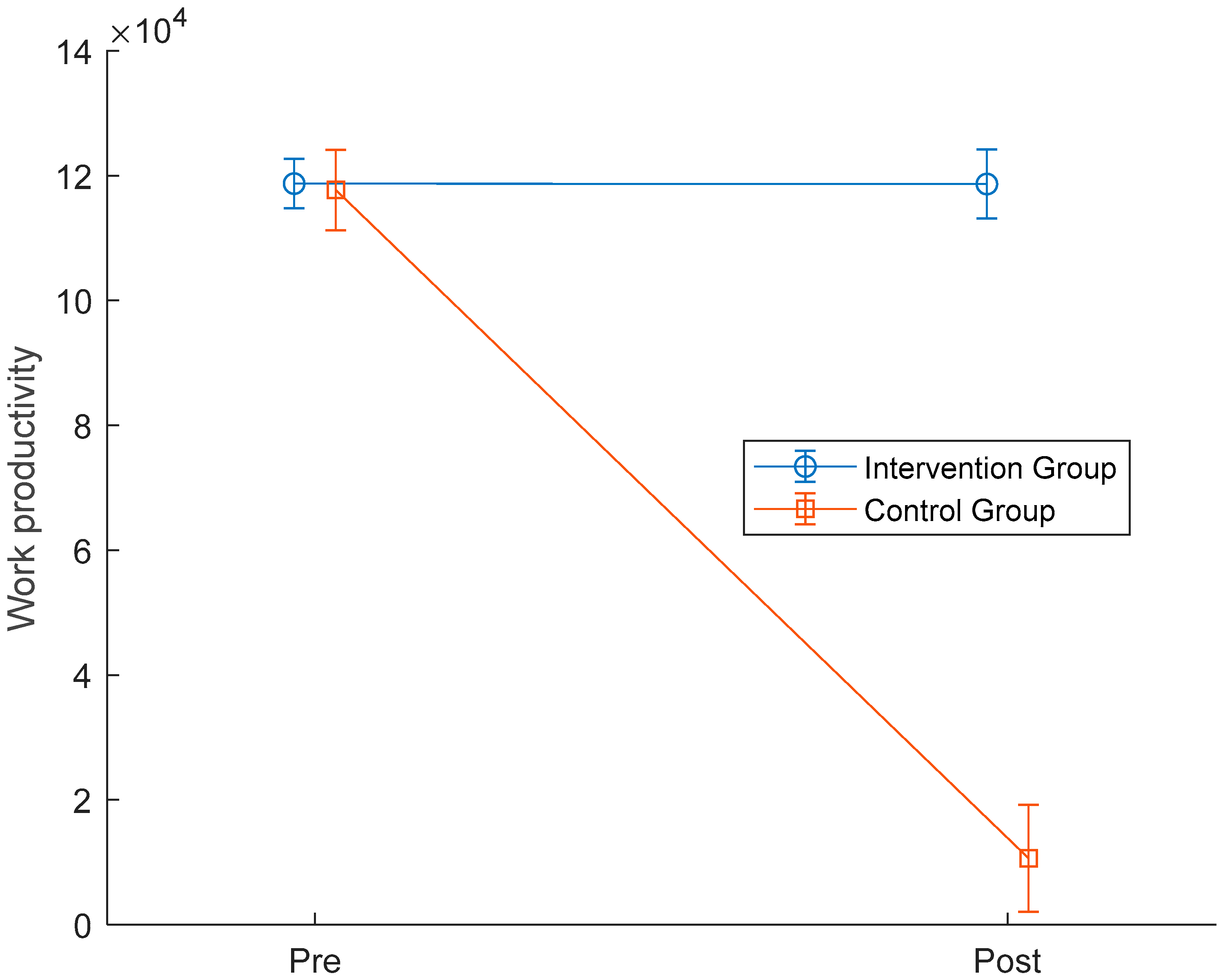
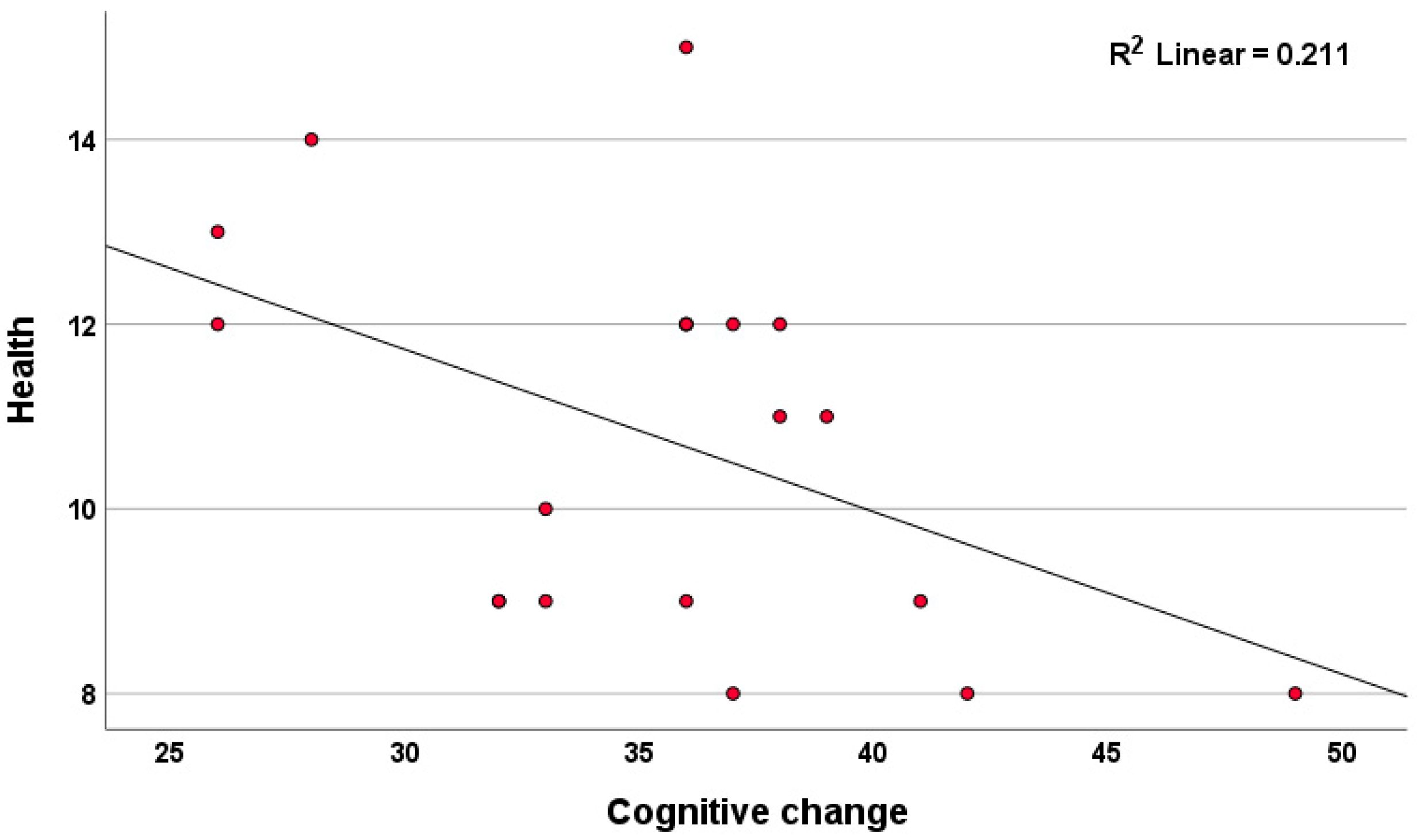
| Intervention Group (n = 19) | Control Group (n = 23) | ||||
|---|---|---|---|---|---|
| Mean | SD | Mean | SD | p Value | |
| Age | 54.55 | 3.19 | 55.72 | 3.94 | 0.31 |
| Gender | F 20, M 0 | F 32, M 4 | |||
| Education (years) | 15.11 | 0.94 | 15.39 | 1.41 | 0.45 |
| Test | Pre-CCT | Post-CCT | RM ANOVA | ||||||
|---|---|---|---|---|---|---|---|---|---|
| Time | Group | Interaction (Time × Group) | |||||||
| M | SD | M | SD | p Value | p Values | F Value | p Value | Partial η2 | |
| VF-L | <0.001 | 0.24 | 4.387 | 0.04 | 0.099 | ||||
| Intervention | 9.16 | 2.79 | 17.32 | 3.82 | |||||
| Control | 9.39 | 2.81 | 15.13 | 3.43 | |||||
| VF-S | 0.06 | 0.14 | 2.31 | 0.14 | 0.061 | ||||
| Intervention | 20.00 | 6.71 | 19.72 | 6.61 | |||||
| Control | 22.45 | 4.27 | 20.03 | 5.35 | |||||
| Digit Span Forward | 0.44 | 0.91 | 0.98 | 0.33 | 0.024 | ||||
| Intervention | 6.32 | 1.06 | 6.37 | 1.01 | |||||
| Control | 6.52 | 1.28 | 6.21 | 1.68 | |||||
| Digit Span Backward | 0.06 | 0.61 | 0.223 | 0.63 | 0.006 | ||||
| Intervention | 5.84 | 1.17 | 6.16 | 1.54 | |||||
| Control | 5.52 | 1.56 | 6.04 | 1.65 | |||||
| AVLT Learning | 0.33 | 0.24 | 0.15 | 0.70 | 0.004 | ||||
| Intervention | 10.35 | 1.37 | 10.23 | 1.06 | |||||
| Control | 9.95 | 1.56 | 9.68 | 1.57 | |||||
| AVLT-IR | 0.27 | 0.23 | 1.49 | 0.23 | 0.037 | ||||
| Intervention | 9.11 | 3.09 | 9.05 | 1.93 | |||||
| Control | 7.68 | 3.76 | 8.82 | 3.02 | |||||
| AVLT-DR | 0.02 | 0.35 | 0.91 | 0.35 | 0.023 | ||||
| Intervention | 8.58 | 2.17 | 9.79 | 1.62 | |||||
| Control | 9.23 | 2.69 | 9.77 | 2.62 | |||||
| Coding | 0.02 | 0.60 | 0.05 | 0.83 | 0.001 | ||||
| Intervention | 51.11 | 8.31 | 54.05 | 9.07 | |||||
| Control | 52.43 | 11.89 | 55.96 | 12.67 | |||||
| Comparison | 0.08 | 0.12 | 0.28 | 0.12 | 0.007 | ||||
| Intervention | 20.37 | 3.37 | 20.26 | 3.56 | |||||
| Control | 20.09 | 4.24 | 18.32 | 2.55 | |||||
| Questionnaire | Pre-CCT | Post-CCT | RM ANOVA | ||||||
|---|---|---|---|---|---|---|---|---|---|
| Time | Group | Interaction (Time × Group) | Partial η2 | ||||||
| M | SD | M | SD | p Value | p Values | p Value | p Value | ||
| Work productivity | 0.086 | 0.433 | 3.015 | 0.09 | 0.070 | ||||
| Intervention | 118,740 | 17,620 | 118,660 | 24,750 | |||||
| Control | 117,700 | 28,910 | 106,400 | 38,310 | |||||
| Life Satisfaction | 0.28 | 0.89 | 0.43 | 0.52 | 0.011 | ||||
| Intervention | 21.17 | 4.23 | 22.44 | 4.93 | |||||
| Control | 21.86 | 5.77 | 22.18 | 5.56 | |||||
| Well-being | 0.73 | 0.48 | 1.34 | 0.26 | 0.034 | ||||
| Intervention | 14.33 | 4.72 | 15.00 | 4.50 | |||||
| Control | 14.23 | 5.51 | 13.00 | 6.06 | |||||
| Job satisfaction | 0.74 | 0.03 | 0.46 | 0.50 | 0.014 | ||||
| Intervention | 37.00 | 9.83 | 38.22 | 8.85 | |||||
| Control | 44.12 | 9.84 | 43.71 | 6.85 | |||||
| Health | 0.95 | 0.33 | 0.57 | 0.46 | 0.015 | ||||
| Intervention | 11.11 | 1.37 | 12.37 | 4.07 | |||||
| Control | 11.45 | 3.88 | 10.41 | 3.13 | |||||
Disclaimer/Publisher’s Note: The statements, opinions and data contained in all publications are solely those of the individual author(s) and contributor(s) and not of MDPI and/or the editor(s). MDPI and/or the editor(s) disclaim responsibility for any injury to people or property resulting from any ideas, methods, instructions or products referred to in the content. |
© 2024 by the authors. Licensee MDPI, Basel, Switzerland. This article is an open access article distributed under the terms and conditions of the Creative Commons Attribution (CC BY) license (https://creativecommons.org/licenses/by/4.0/).
Share and Cite
Milič Kavčič, Z.; Kavcic, V.; Giordani, B.; Marusic, U. Computerized Cognitive Training in the Older Workforce: Effects on Cognition, Life Satisfaction, and Productivity. Appl. Sci. 2024, 14, 6470. https://doi.org/10.3390/app14156470
Milič Kavčič Z, Kavcic V, Giordani B, Marusic U. Computerized Cognitive Training in the Older Workforce: Effects on Cognition, Life Satisfaction, and Productivity. Applied Sciences. 2024; 14(15):6470. https://doi.org/10.3390/app14156470
Chicago/Turabian StyleMilič Kavčič, Zdenka, Voyko Kavcic, Bruno Giordani, and Uros Marusic. 2024. "Computerized Cognitive Training in the Older Workforce: Effects on Cognition, Life Satisfaction, and Productivity" Applied Sciences 14, no. 15: 6470. https://doi.org/10.3390/app14156470






